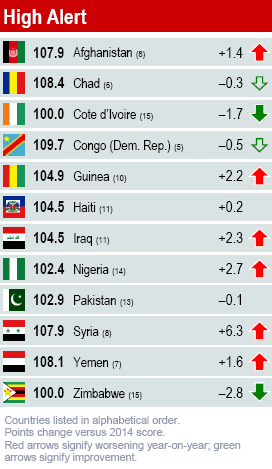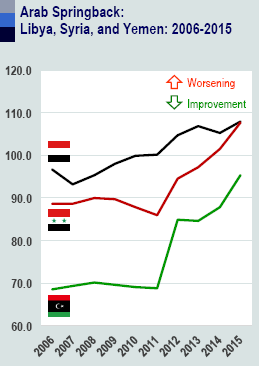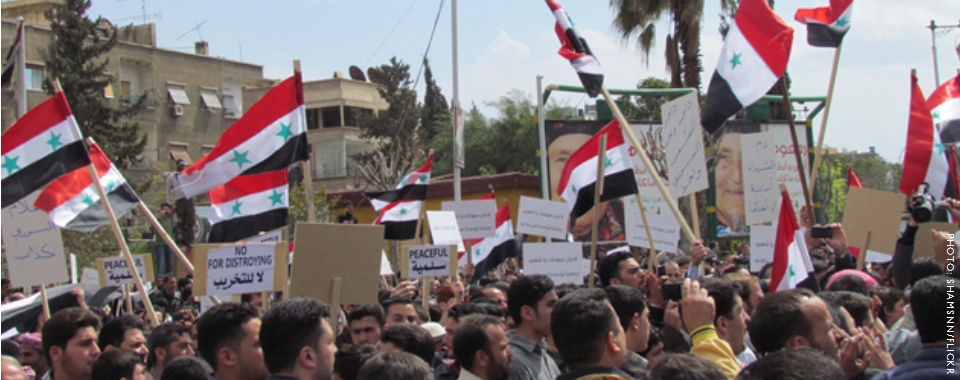BY FELIPE UMAÑA
 Only a few years ago, much of the Fragile States Index analysis was following the aftermath of the Arab Spring. At the time, there was significant hope for the future, as the despotic regime of Muammar Gaddafi fell in Libya, similarly undemocratic regimes collapsed in Egypt and Tunisia, and other countries hastily rushed through liberal, democratic reforms in the hopes of staving off their own demise. But fast forward only a few years, and (despite generally positive signs in Tunisia) most of that hope has evaporated. Iraq, Libya, Syria and Yemen — among the 2015 Index’s most high risk nations — have witnessed some of the most significant declines over the past year.
Only a few years ago, much of the Fragile States Index analysis was following the aftermath of the Arab Spring. At the time, there was significant hope for the future, as the despotic regime of Muammar Gaddafi fell in Libya, similarly undemocratic regimes collapsed in Egypt and Tunisia, and other countries hastily rushed through liberal, democratic reforms in the hopes of staving off their own demise. But fast forward only a few years, and (despite generally positive signs in Tunisia) most of that hope has evaporated. Iraq, Libya, Syria and Yemen — among the 2015 Index’s most high risk nations — have witnessed some of the most significant declines over the past year.
For this year’s Index, Yemen saw over a 3-point increase primarily as a result of the political and social unrest fomented by the Houthi movement in August, as well as the rebel group’s subsequent attempts to seize political power in Sana’a. Though much has occurred in Yemen during 2015 to suggest that its score will worsen even more in the 2016 Index, it was evident that the country’s fortunes were already getting worse over the past year. For example, moves by the former government, such as the decision to remove fuel subsidies from impoverished provinces, prompted many to demonstrate and take up arms, leading to increases in Yemen’s Uneven Development indicator score. More broadly, this unrest became the catalyst for the burgeoning conflict for the remainder of the year. Though a UN-brokered deal offered some hope for political security, conditions steadily worsened in late 2014 and violence erupted, as evidenced by a stark rise in several indicators. Of course, the 2015 Index does not reflect the subsequent resignation of the government in January 2015, and the power grab by the Houthis that has led Yemen to deteriorate even further, continuing a long-running trend that has seen Yemen rank as one of the world’s ten most fragile states for four years running.
 Syria saw a decline from 164th on the 2014 Index to 170th in 2015, with an 8-point increase in its total score as it saw worsening conditions in virtually all of its indicators. The complex conflict in the country has continued to pit President Bashar al-Assad’s regime against a weakened armed opposition and various jihadist militants, including al-Qaeda’s Jabhat al-Nusra and its rival, the Islamic State. The latter has wreaked havoc throughout much of the country’s central, eastern, and northern provinces and has exacerbated existing issues with refugee and migrant populations, ethnic and sectarian grievances, human rights abuses, and overall violence and instability — all indicators with a maximum possible score of 10 points.
Syria saw a decline from 164th on the 2014 Index to 170th in 2015, with an 8-point increase in its total score as it saw worsening conditions in virtually all of its indicators. The complex conflict in the country has continued to pit President Bashar al-Assad’s regime against a weakened armed opposition and various jihadist militants, including al-Qaeda’s Jabhat al-Nusra and its rival, the Islamic State. The latter has wreaked havoc throughout much of the country’s central, eastern, and northern provinces and has exacerbated existing issues with refugee and migrant populations, ethnic and sectarian grievances, human rights abuses, and overall violence and instability — all indicators with a maximum possible score of 10 points.
The situation in Iraq mirrors that of neighboring Syria, as many of Syria’s same ailments afflict Iraq’s economic, political, and social conditions. While rising oil exports and a key oil revenue compromise with the northern Kurdish population prompted minor improvements from the country’s 2014 Uneven Development and Poverty indicator scores, Iraq has lost nearly one-third of its territory to the Islamic State. Legitimacy similarly wilted under persisting sectarian enmity and international humanitarian and military intervention.
Finally, post-Gaddhafi Libya continued to deteriorate in 2014, as the internationally recognized government was forced to depart in August to the eastern port city of Tobruk. Various indicators further declined as militant groups — including those allied with the Islamic State — dislodged the government’s authority and assumed the role of providing critical services to the war-weary population. While Demographic Pressures and Uneven Economic Development improved marginally, oil production suffered due to ongoing fighting. Importantly, the country’s Refugee and Human Flight scores saw large increases, further contributing to the still-ongoing Mediterranean migrant crisis. Though Libya gained an Alert rating in the 2015 Index, there is every reason to expect that in the coming years, without stemming the current tide, Libya could join Iraq, Syria, and Yemen with a High Alert rating. Unfortunately, though there was great hope for an Arab Spring, the region could well be in for a long Winter.
